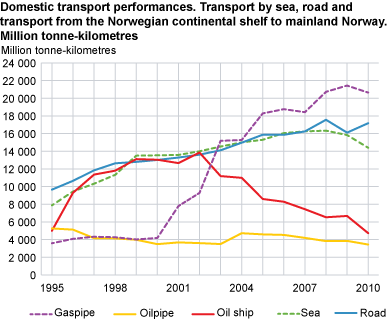Content
Published:
This is an archived release.
Road goods transport - back on track
The transport work by lorry comprised 17.2 billion tonne-kilometres in 2010; an increase of 6.6 per cent from 2009. The total passenger transport increased by 1.1 per cent to 73.7 billion passenger kilometres in 2010.
|
Figures for goods traffic by rail were corrected 16 September 2011 due to new data. |
In the period 2000-2008, the transport of goods by lorry increased by 35 per cent to 17.6 billion tonne-kilometres. In 2009, the statistics reveals a fall in both the transport performances and tonnes transported by 8 per cent and 10 per cent respectively. The decline was, however, short-lived. Already in the next year; 2010, the goods lorry trade experienced a new increase in the transport of goods. While the transport work increased by almost 7 per cent compared to 2009, the tonnes transported increased by 3 per cent to 279 million tonnes.
The maritime transport of goods experienced a decline in transport...
Transport of goods at sea experienced a positive trend at the beginning of the 21st century including 2008. This year, the transport performances constituted 16.3 billion tonne-kilometres. However, as was the case for the road transport, the maritime transport also experienced tighter economic frames in 2009. The decrease came to 3 per cent; 15.8 billion tonne-kilometres. This was a smaller decrease compared to the road goods transport. In contrast to the road goods transport, however, the transport of goods by sea continued to diminish in 2010. The transport work this year fell by 9 per cent compared to 2009, to 14.4 billion tonne-kilometres.
... as did the goods traffic by rail1
The transport of goods by rail has also increased in recent years, including 2009. Tonnes transported in 2010 constituted 7.4 million; a decrease compared to 2009 by almost 4 per cent. The transport work by rail came to 2.3 billion tonne-kilometres. This was a reduction of 9 per cent compared to 2009. As the reduction measured in tonne transported is less than the reduction in tonnes-kilometres, the average length of transport has increased to 320 kilometres in 2010. An indication of this is that the previous shorter trips by rail to a certain extent are transferred to lorries.
More than four out of five journeys are made by private car
Almost 4.2 billion journeys were made by private car in 2010. This was a share of almost 83 per cent of all journeys this year. The average length of journey by a private car is shorter than all the other means of transport put together. Therefore, the private car is not as dominant measured by passenger kilometres. In 2010, the transport work by private cars comprised 57 billion passenger kilometres; a share of 77 per cent of the total transport performances. Compared to 2009, this was an increase below 1 per cent. This is the lowest increase since 2005.
Six per cent growth in travel by suburban railways and urban tramways
In recent years, the traffic by suburban railways and urban tramways has increased. In the period 2005-2010, the increase in travel constituted almost 30 per cent. From 2009 to 2010, the increase was 6 per cent to 125 million journeys. The increase in 2010 must be viewed in conjunction with the opening of Bybanen in Bergen in June 2010. The passenger traffic by rail comprised almost 59 million passenger journeys in 2010; an increase of 2 per cent from 2009.
| 1Figures for goods traffic by rail were corrected 16 September 2011 due to new data. |
Tables:
Contact
-
Geir Martin Pilskog
E-mail: geir.martin.pilskog@ssb.no
tel.: (+47) 40 81 13 83

